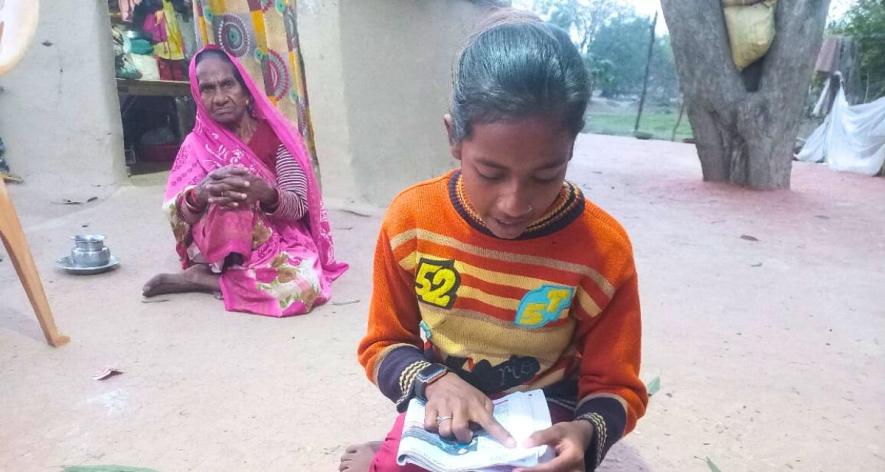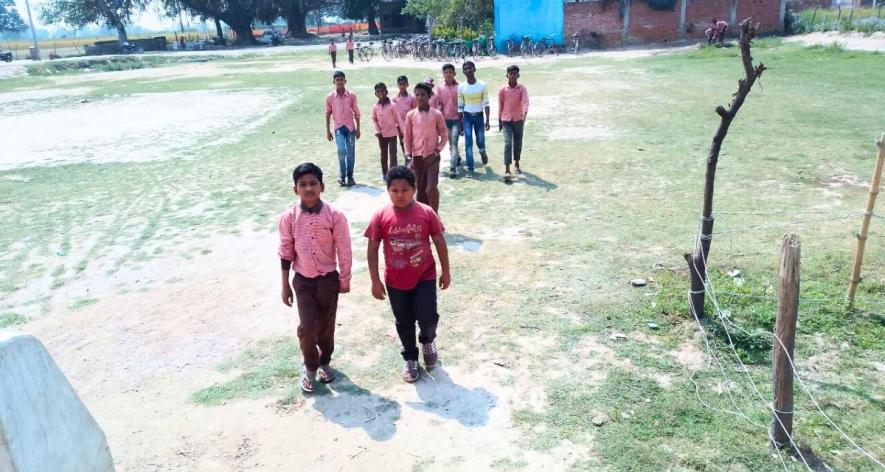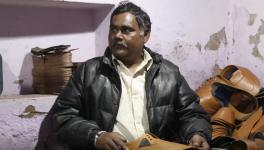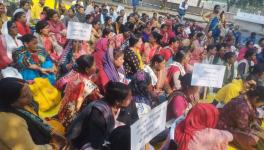Why Attendance is a Golden Word in Schools of Rural Uttar Pradesh

A student reading a book.
Unnao, Uttar Pradesh: Only 21 students are enrolled in the Koratganj Mehandi Nagar Upper Primary School at Sikanderpur Karan block of Unnao district. Of the total 12 boys present is Shuyash Yadav* (13), studying in class 8. There are only four students in Shuyash's class — a clear pointer to what is wrong with the education system in Uttar Pradesh.
The school is just 700 m away from Shuyash's house. Yet, attending classes daily seems like a big challenge as Shuyash is the eldest child in the family. His father works in a brick kiln in Punjab, so he has to be there for his mother and younger brother.
Shuyash has great difficulty reading the four letter words in his Hindi textbook. Mathematics and English are beyond his comprehension. Ask why, and Shuyash's mother Gudiya Devi (36) expresses her helplessness. “I do not know what to do. There is no progress even after going to school. How will he learn without being taught something? The teacher comes to school to take some rest. No one tries to teach the children, they just sit and have fun,” alleges Gudiya, who has studied till class 8.
When asked about this, Principal Shiv Pratap Yadav tells 101Reporters that the educational standards of weak students will improve only when the teachers and parents work together. "Children not coming to school regularly is a big challenge. When parents are contacted, they also hesitate to come to school," he says.
Saurabh Kumar* (11) of Ramsingh Kheda village in Bichhiya block is a class 6 student of the upper primary school at Behta Nathai Singh, located one-and-a-half km away from his house. There are 36 students in Saurabh’s class, but only 25 or 30 attend. After returning from school, Saurabh has to take the goats for grazing. His father Kallu Prasad (38) goes out for work as a brick kiln labourer at the break of the dawn itself. Being the eldest of his three children, Saurabh has the responsibility of taking care of siblings at home when his mother Nisha Devi (36) finds work in the fields. He goes to school only on those days when his mother is at home.
When asked to translate the sentence ‘yeh mera school hai’ to English, he simply smiled and replied, “nahin aata hai [I do not know].” As if to reason out, he adds, “School mein angrezi grammar nahi padhayi gayi hai [English grammar has not been taught in the school].”
“Hindi, English, Mathematics, Social Science, Sanskrit and painting are taught. Madam was saying that she will teach grammar later. Right now, she is teaching literature,” he elaborates. Saurabh knows up to 20 in mathematics. When asked to add up 80 and 40, he struggled and took a lot of time before coming up with the correct answer.
“I am illiterate. I do not know how much Saurabh knows. I try to send him to school every day, but when I work as a labourer or find work in the fields, he has to take care of the house. For us, along with studies, work is also important. Otherwise, how will we feed and clothe the children,” asks Nisha Devi (36), Saurabh's mother.
The upper primary school at Chandanpur in Sikanderpur Karna block has 128 students. Though 40 students are registered in class 7, around 10 to 15 children remain absent every day. Out of the 25 to 30 children coming to school, only 10 to 12 are good at reading and writing. These are regular attendees, while the rest come only when there is no work at home.
Aman Yadav* (12) studies in this class, but he is not able to read even a single line from his Hindi textbook. “When there is work in the field, he helps me out. Agriculture is our livelihood, so what will we eat if we do not work?” says Aman's father Phool Singh Yadav (34), a farmer.
Phool Singh understands the virtues of education, but is equally hopeless. “If he does not study, what can we do? We are doing whatever we can. If he does not study, he will do farming. Anyway, will we get a job after studying?”
Manvi Kashyap* (13), a class 7 student in the upper primary school at Aderwa, Bichhiya block, can read simple words from her English textbook but does not know grammar because she has not been taught that yet. “No one in my house can teach me. When I do not understand something while studying at home, I ask the teacher the next day,” says Manvi, who has completed her primary schooling in the same institution and has two younger sisters.
There are 38 students in her class, but half of them do not attend. According to Manvi, children hide or scoot from their homes when the teacher comes home to call them to school. “Due to not going to school every day, these children find it difficult to read Hindi books,” says Manvi, whose father Shyam Bahadur Kashyap (36) has studied till class 10 and sells momos. Her mother Vibha Devi is illiterate.
What teachers say
According to headmaster Sukhbir Singh (42), the upper primary school at Behta Nathai Singh has 97 children enrolled. Only about half of them attend classes. “Besides the household responsibility, it is the parents’ attitude about education that reflects on the poor attendance of their children. The parents of most of the children are less educated; many of them are illiterate. For them, household work and labour are more important than studies. We constantly contact the families and urge them to send their children to school regularly. But when farm work starts, attendance goes down,” Sukhbir says.
Regarding the quality of education, Sukhbir argues that there are five teachers in the school. “If children come to school, there will be educational improvement in them… It is also necessary that children study at home. Most of the children who come here are from poor families. They have to do farm work or graze animals after returning home. Every year, eight to 10 children drop out of school by the time they reach class 8. Most of the children are unable to support the family financially, so they start working as labourers. This is also a big challenge for us,” he explains.
Chandanpur Upper Primary School has 128 students, but the attendance never crossed 70-80. If farming work is going on, it plummets to 30-40. “We visit the homes to call children out. The mostly illiterate or less educated parents think that education is all about getting a government job. When they come across someone educated but not having a government job, they form this opinion that education is useless,” headmistress Sajiya Siddiqui tells 101Reporters.
Siddiqui informs that the school has three teachers and two instructors. “The Right to Education Act, 2009, states that no child should fail. So despite being weak, one has to promote the children to the next class. This sequence continues till class 8,” she adds.

Children going to the upper primary school (Photo - Sumit Yadav)
Ranjana Devi, the head of the upper primary school in Aderwa, says educational standards of children entering class 6 is very poor. “A big reason for this is that no child can be failed till class 8.”
The National Education Policy 2020 Report states that the gross enrolment ratio for classes 6 to 8 is 90.9%, while it reaches 79.3% in classes 9-10 and 56.5% in classes 11-12. This indicates that a large number of students drop out of schools after class 8.
The condition of education in most of the rural schools is poor. The Annual Status of Education Report 2023 (ASER-2023) shows that the educational quality of children studying in primary and upper primary schools in rural India is very poor, with 42% of the children aged 12-18 years not capable of dividing a three-digit number by a one digit number.
The ASER 2022 assessments of children in the five to 16 age group suggest that 49.8% children in class 6 in Uttar Pradesh can read simple words in English, but cannot read sentences. For classes 7 and 8, these were 53.5% and 55.2%, respectively. In Mathematics, 26.9% children could recognise numbers from 11-99, while it is 25.2% and 23.9% in classes 7 and 8, respectively.
Vacant posts of teachers are also responsible to a great extent for the quality of education. There are 41,338 vacant posts in upper primary schools in Uttar Pradesh. However, in response to a question from MLA Anil Pradhan, Basic Education Minister Sandeep Singh told the Assembly on February 6 that the student-teacher ratio was 29:1 with 1,20,860 teachers and 27,555 instructors present in upper primary schools of Uttar Pradesh.
To assist weak children, the Uttar Pradesh Basic Education Department runs Nipun Bharat Abhiyan, under which teams of subject expert teachers are formed at the block level. These teams conduct weekly additional classes in every school and teach through activities that suit the children's behaviour. They are even taught using fun games.
Dr Rachna Singh, member, state resource group, tells 101Reporters that many types of programmes are run at the school level to improve the educational standards of weak children. "Under Nipun Bharat, we give emphasis to activity-based education instead of lectures. We run remedial classes for weak learners. Along with the children, we are trying to connect their parents with the school. The more aware the parents are, the easier it will be to make efforts to improve their children's educational standards," Rachna says.
The dropout rate and student-teacher ratio in schools are the big reasons for the pathetic educational quality of children. Perhaps this is why children studying in upper primary schools of Uttar Pradesh are illiterate even after studying.
*Names changed to protect privacy
Sumit Yadav is an Uttar Pradesh-based freelance journalist and a member of 101Reporters, a pan-India network of grassroots reporters.
Get the latest reports & analysis with people's perspective on Protests, movements & deep analytical videos, discussions of the current affairs in your Telegram app. Subscribe to NewsClick's Telegram channel & get Real-Time updates on stories, as they get published on our website.
























